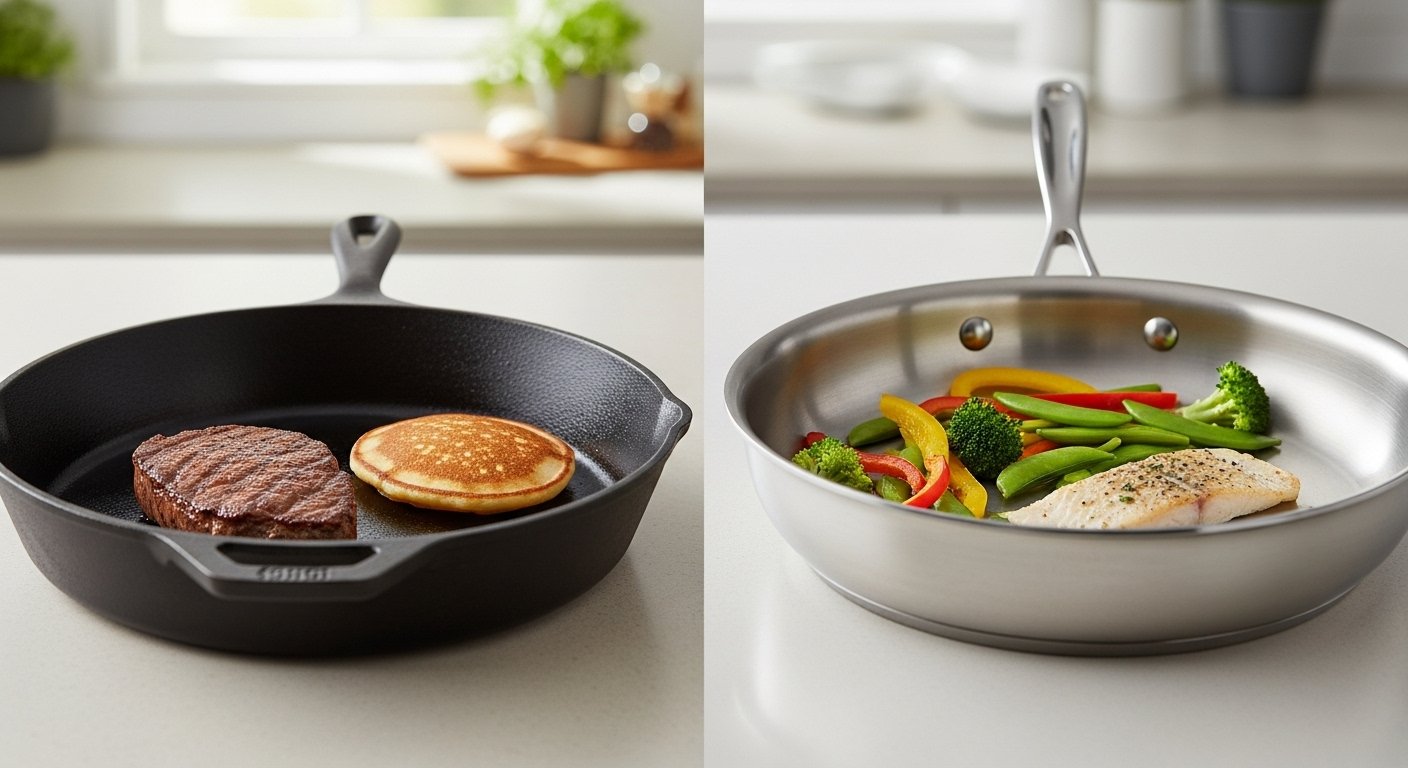Choosing the right cookware is a fundamental step for any aspiring chef or home cook. Among the myriad of options available, the cast iron vs stainless steel skillet debate is one of the most enduring. Both materials have fervent advocates, celebrated for their unique characteristics and performance in the kitchen. But when it comes to which is best for your culinary adventures, the answer isn’t always straightforward – it largely depends on your cooking style, the dishes you prepare, and your priorities. This comprehensive guide will delve into the distinct properties of each, helping you make an informed decision for your kitchen.
For those seeking a quick answer, there isn’t a single ‘best’ pan. Instead, the optimal choice between a cast iron skillet and a stainless steel skillet hinges on specific cooking tasks. Cast iron excels in heat retention and achieving a perfect sear, while stainless steel offers superior heat responsiveness and versatility for a wider range of culinary techniques, including deglazing and cooking acidic foods. Understanding these core differences is key to mastering your kitchen. The global cast iron cookware market, for instance, was estimated at USD 5.08 billion in 2023 and is projected to reach USD 9.18 billion by 2030, growing at a Compound Annual Growth Rate (CAGR) of 8.9% from 2024 to 2030, indicating its enduring popularity. Meanwhile, stainless steel held a significant 34.56% share of the overall cookware market in 2024, underscoring its widespread use. [1]
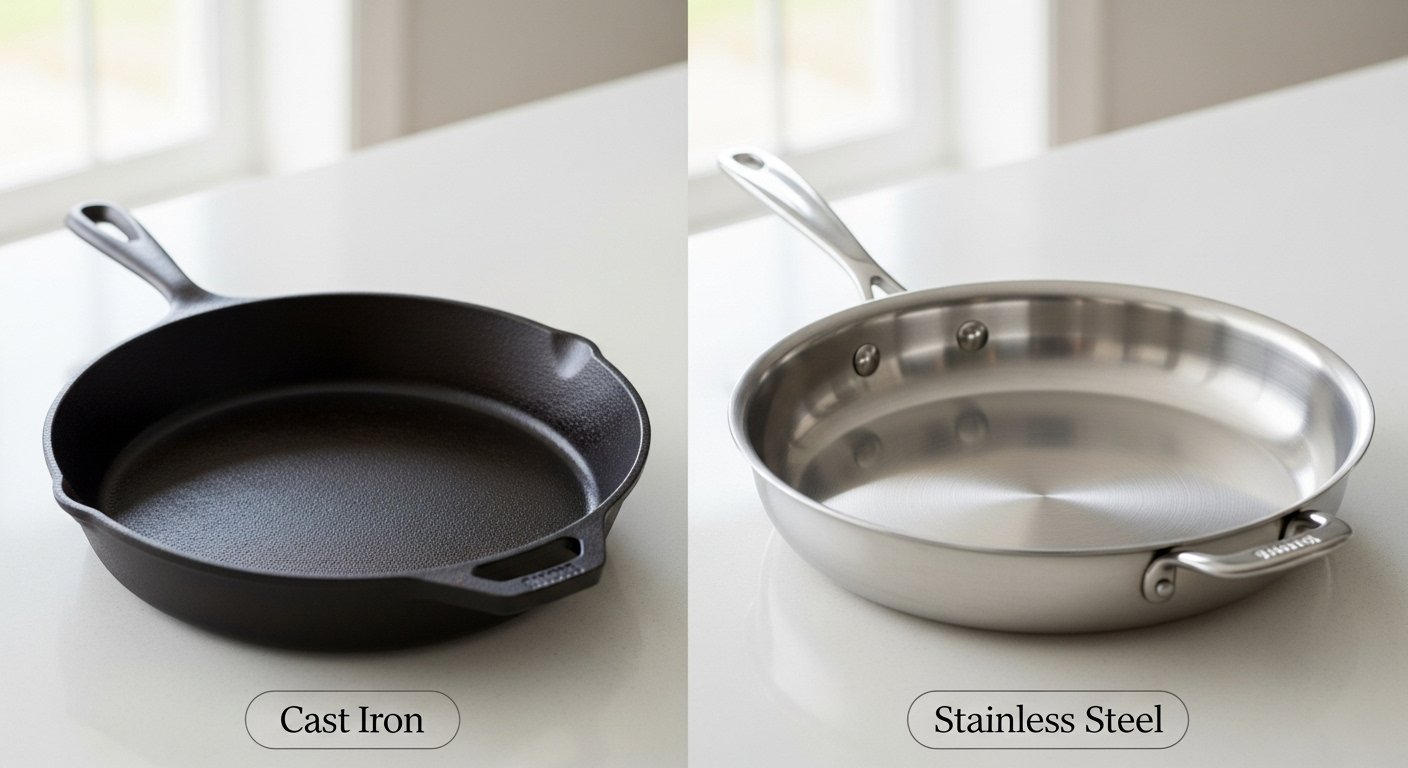
Understanding the Contenders: Cast Iron Skillet
Cast iron skillets have been kitchen staples for centuries, prized for their robustness and ability to withstand incredibly high temperatures. Made from a single piece of iron, these pans are known for their rustic charm and heirloom quality.
Pros of a Cast Iron Skillet:
Key Takeaways
- **Superior Heat Retention:** Once a cast iron skillet gets hot, it stays hot. This makes it ideal for tasks requiring consistent, high heat, such as searing steaks or deep-frying. Cast iron boasts superior heat retention, staying hot and distributing heat evenly once heated. [3]
- **Natural Non-stick Properties (with Seasoning):** With proper seasoning, a layer of polymerized oil baked onto the surface, cast iron develops a remarkably slick, naturally non-stick finish that improves with every use. [7]
- **Durability and Longevity:** A well-cared-for cast iron skillet can last for generations. It’s incredibly resilient and can handle rigorous use, even direct flame.
- **Iron Fortification:** Cooking with cast iron can lead to the leaching of iron into food, which can be a beneficial effect for those needing to increase their iron intake, potentially reducing the incidence of iron deficiency anemia. [5]
Cons of a Cast Iron Skillet:
Key Takeaways
- **Weight:** Cast iron pans are notoriously heavy, which can make them cumbersome for some users, especially when handling hot food.
- **Maintenance (Seasoning):** While beneficial, seasoning requires specific care, including hand-washing without harsh soaps and regular re-oiling to prevent rust and maintain its non-stick surface. Acidic foods can also strip seasoning. [8]
- **Rust:** If not properly dried and seasoned, cast iron is prone to rust.
- **Heat Responsiveness:** Due to its excellent heat retention, cast iron is slow to heat up and slow to cool down, offering less immediate temperature control than stainless steel. [3]
Understanding the Contenders: Stainless Steel Skillet
Stainless steel skillets are a workhorse in professional and home kitchens alike, celebrated for their sleek appearance, versatility, and ease of use. Unlike solid cast iron, quality stainless steel cookware is typically multi-clad, featuring layers of aluminum or copper sandwiched between stainless steel to improve heat conductivity and distribution. [6]
Pros of a Stainless Steel Skillet:
Key Takeaways
- **Excellent Heat Responsiveness:** Stainless steel heats up and cools down quickly, allowing for precise temperature adjustments, crucial for delicate sauces or temperature-sensitive dishes. Stainless steel is known for excellent heat conductivity, allowing for quicker heating and cooling for precise temperature control. [3]
- **Versatility:** Stainless steel is non-reactive, meaning it won’t leach metals or react with acidic ingredients like tomatoes or wine, making it suitable for a wide array of dishes. It’s also often oven-safe and induction compatible.
- **Easy Maintenance and Cleaning:** Stainless steel is incredibly easy to clean and maintain. Most stainless steel pans are dishwasher safe, and stubborn messes can be tackled with abrasives or specialized cleaners without damaging the surface. [2]
- **Durability:** While different in nature from cast iron’s robustness, stainless steel exhibits high tensile strength, ranging from 500 MPa to over 2,000 MPa, making it highly resistant to stretching and pulling forces. It is also resistant to dents, scratches, and corrosion. [4]
Cons of a Stainless Steel Skillet:
Key Takeaways
- **Less Heat Retention:** Compared to cast iron, stainless steel doesn’t hold onto heat as long, which can be a disadvantage for maintaining consistent high temperatures.
- **Potential for Sticking:** Without sufficient oil or proper technique, food can stick to stainless steel surfaces, particularly at high temperatures.
- **Price:** High-quality, multi-clad stainless steel cookware can be more expensive upfront than cast iron.
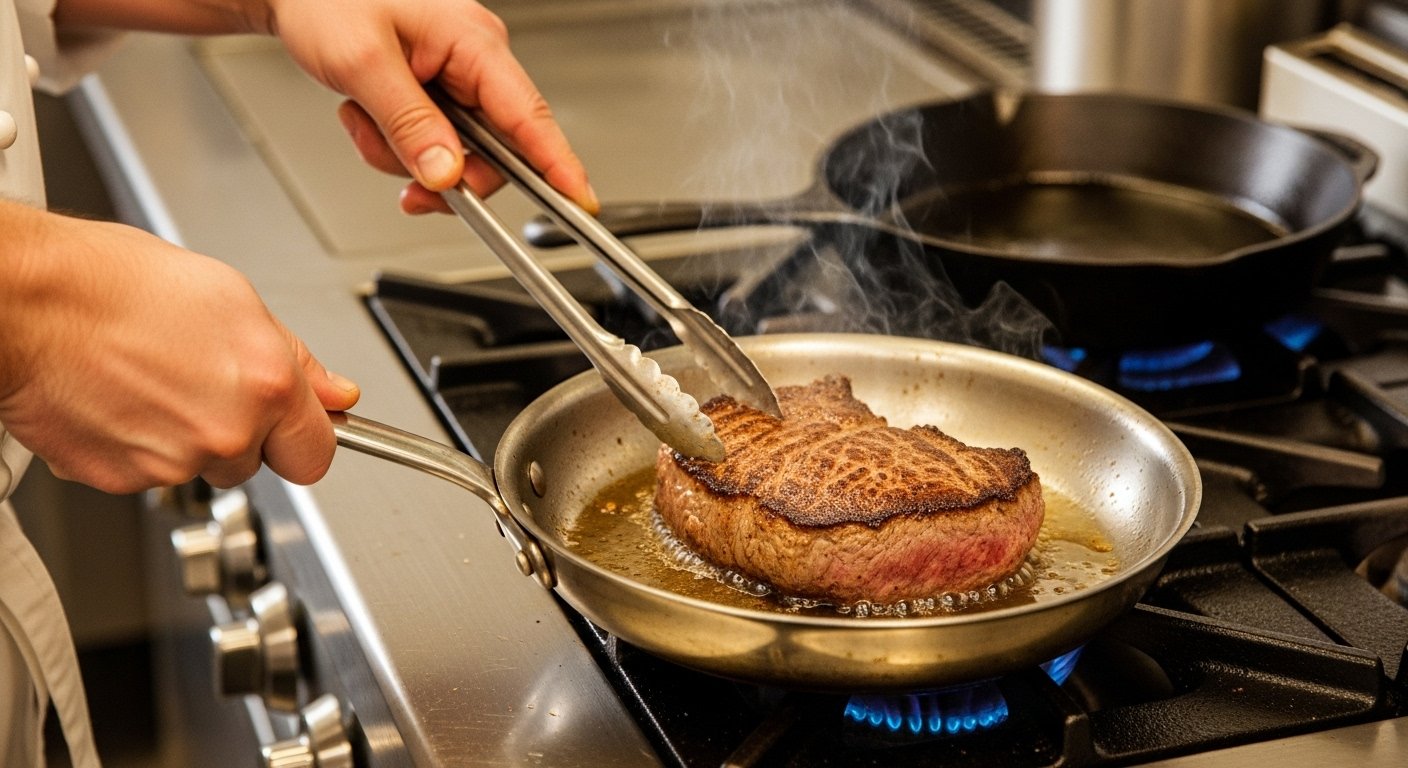
Key Differences: Cast Iron vs Stainless Steel Cooking
When comparing cast iron vs stainless steel cooking, the distinct properties of each material lead to significant differences in how they perform and the culinary results they deliver. Understanding these nuances is vital for anyone looking to elevate their cooking. What are the differences between ‘cast iron’ and ‘stainless steel’ pans or skillets in cooking? Let’s explore.
Heat Dynamics: Retention, Responsiveness, and Distribution
One of the most crucial distinctions lies in their heat characteristics. Cast iron’s dense structure means it excels at heat retention, making it perfect for holding a steady temperature. Once hot, it provides an incredibly even heat that can be beneficial for deep-frying or achieving a consistent crust on bread. However, this also means it’s slow to react to changes in heat settings. [3]
Stainless steel, particularly multi-clad versions, boasts excellent heat conductivity and responsiveness. It heats up quickly and cools down almost instantly when removed from the heat, giving you precise control over cooking temperatures. This responsiveness is invaluable for delicate tasks or when you need to quickly adjust the heat to prevent burning. While it heats evenly, it doesn’t retain heat as well as cast iron once removed from the stove. [5]
Searing and Browning: The Best Pan for Searing
For many, the question of the best pan for searing is paramount. Here, cast iron often takes the crown. Its superior heat retention and high thermal mass allow it to maintain a consistent high temperature even when cold food is added, resulting in a beautiful, crispy crust and rich browning. For a perfect steak, a searing-hot cast iron skillet is hard to beat, as detailed in our guide on how to cook a perfect steak. [12]
Stainless steel can also achieve excellent searing, especially with proper preheating and adequate oil. However, it may require a slightly higher initial temperature to compensate for its lower heat retention upon food contact.
Cooking Versatility: Acidic Foods and Deglazing
When it comes to versatility, stainless steel pulls ahead. Its non-reactive surface makes it ideal for cooking acidic foods like tomato sauces, lemon curds, or wine-based reductions without the risk of metallic flavors or damage to the pan’s surface. Deglazing, a technique essential for building rich pan sauces, is also perfectly suited for stainless steel, as its smooth surface allows you to easily scrape up flavorful fond. [4]
Cast iron, on the other hand, can react with acidic ingredients, potentially imparting a metallic taste to your food and stripping away its hard-earned seasoning. This makes it less suitable for long-simmering acidic dishes.
Non-stick Properties: Cast Iron vs Stainless Steel Nonstick
How “non-stick” are cast iron pans compared to stainless steel pans? A well-seasoned cast iron skillet offers impressive natural non-stick capabilities, often allowing eggs to slide off with ease. This is achieved through the polymerization of oils, which creates a slick, durable surface over time. [7]
Stainless steel, by itself, is not inherently non-stick. Achieving a non-stick effect requires careful temperature control and the use of cooking fats. However, many cooks prefer stainless steel for tasks where fond (the browned bits that stick to the bottom of the pan) is desirable, as these are crucial for building flavor in sauces.
Durability and Longevity: Which is More Durable, Cast Iron or Stainless Steel?
Both cast iron and stainless steel are celebrated for their durability, but in different ways. Cast iron is incredibly robust and resistant to warping, making it a true workhorse. Its main vulnerability is impact, as it has a lower tensile strength of around 150-200 MPa and is more prone to cracking under impact. [4]
Stainless steel, while not as heavy or brittle as cast iron, is highly resistant to dents, scratches, and corrosion. Its high tensile strength (500 MPa to over 2,000 MPa) means it’s less likely to bend or break under normal kitchen stresses. [4] With proper care, both can last for many decades, if not generations.
Maintenance and Cleaning: Cast Iron vs Stainless Steel Maintenance
The maintenance routines for each pan material differ significantly.
Cleaning Cast Iron Skillet: Maintaining cast iron revolves around preserving its seasoning. This typically involves hand-washing with hot water and a stiff brush or scraper, avoiding harsh detergents (which can strip the seasoning), and promptly drying the pan thoroughly. A light coat of cooking oil after cleaning helps maintain the seasoned layer. Over time, regular cooking, especially with fats, enhances the seasoning, making the pan increasingly non-stick. [7]
Cleaning Stainless Steel Pan: Stainless steel is much more forgiving. Most stainless steel pans are dishwasher safe, although hand-washing is often recommended to preserve their finish. Stubborn stuck-on food can be soaked, scrubbed with an abrasive pad, or even boiled with water and baking soda. Discoloration from high heat can often be removed with a specialty stainless steel cleaner or a vinegar solution. [2]
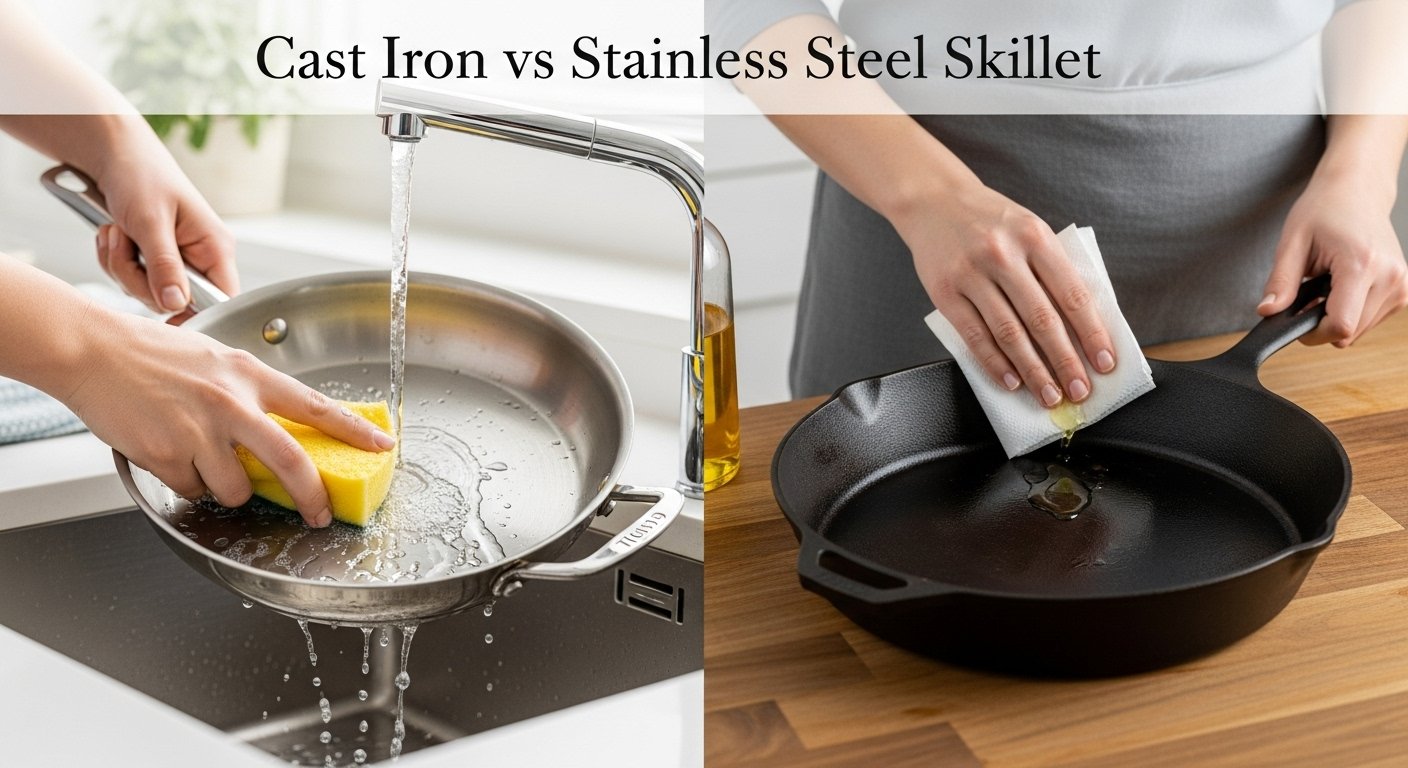
Health Considerations: Stainless Steel vs Cast Iron Health
From a health perspective, both are generally considered safe and beneficial. As mentioned, cooking with cast iron can naturally fortify your food with dietary iron, which can be particularly advantageous for individuals with iron deficiency. Studies have shown that iron content in food can increase significantly when cooked in cast iron, especially with acidic ingredients. [5, 13]
Stainless steel is inert and non-reactive, meaning it will not leach metals into your food, even when cooking acidic ingredients. This ensures the purity of flavors and avoids any unwanted chemical interactions, making it a very healthy choice for diverse cooking. [4]
Choosing Your Champion: Which is Best for Your Kitchen?
So, is it better to cook in cast iron or stainless steel? Which pan to choose between cast iron and stainless steel? The answer ultimately depends on your culinary goals and preferences.
When to Choose Cast Iron:
When to Choose Stainless Steel:
The Ideal Kitchen: A Dynamic Duo
For many experienced cooks, the best skillet material isn’t an either/or proposition but a harmonious blend of both. Owning both a cast iron and a stainless steel skillet allows you to leverage the strengths of each, adapting your cookware to the specific demands of your recipe. For example, you might sear a steak in cast iron and then create a pan sauce in a stainless steel pan using the fond. Consider exploring other essential kitchen gadgets for aspiring chefs to round out your collection.
Cast Iron vs Stainless Steel for Indian Cooking
When considering cast iron vs stainless steel for Indian cooking, both have their place. Stainless steel is highly favored for its non-reactivity, which is crucial when working with the often acidic ingredients found in many Indian curries and gravies, such as tomatoes, yogurt, and tamarind. Its quick heat responsiveness is also excellent for tempering spices (tadka) or quick stir-fries. Cast iron, however, is exceptional for dishes requiring deep, even heat, like making crispy dosas, uttapams, or slow-cooked curries that benefit from sustained heat. It can also impart a unique flavor and, as noted, contribute to iron intake. [11]
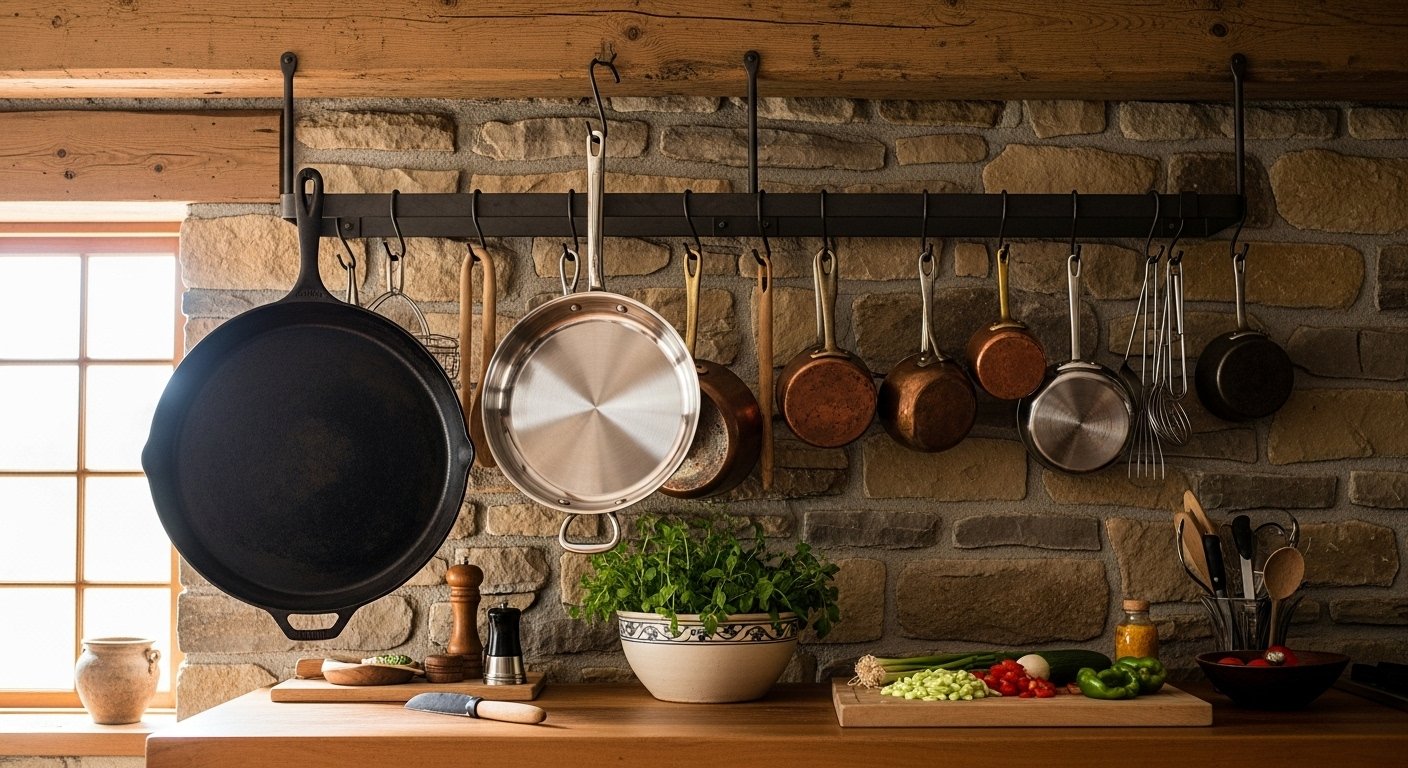
What is the Best Skillet to Own?
Ultimately, the best skillet to own depends on your personal cooking journey. If you’re a student just starting out, a good quality stainless steel pan might offer more immediate versatility and easier maintenance for a broader range of everyday cooking tasks. For example, if you’re trying to decide between a slow cooker vs instant pot for busy cooks, you’ll find similar considerations about versatility and ease of use. [internal link: https://dankwoodstore.com/slow-cooker-vs-instant-pot-busy-cooks/]
If you regularly cook dishes that benefit from intense, sustained heat, like seared meats or oven-baked meals, and are willing to commit to the specific care requirements, then a cast iron skillet will be an invaluable asset. Many culinary enthusiasts find that having both materials available provides the ultimate flexibility and performance.
Key Takeaways: Cast Iron vs Stainless Steel Skillet
Key Takeaways
- **Cast iron** excels in **heat retention**, ideal for **searing** and high-heat cooking, and can naturally provide dietary iron. It requires specific **seasoning and maintenance**.
- **Stainless steel** offers superior **heat responsiveness** and **versatility**, is **non-reactive** for acidic foods, and is **easy to clean**. It is highly **durable** with high tensile strength. [4]
- For the **best pan for searing**, cast iron often wins due to its ability to maintain consistent high temperatures.
- For general **everyday cooking** and tasks involving **acidic foods** or **deglazing**, stainless steel is often preferred.
- Many kitchens benefit from owning both types of skillets to capitalize on their individual strengths.
